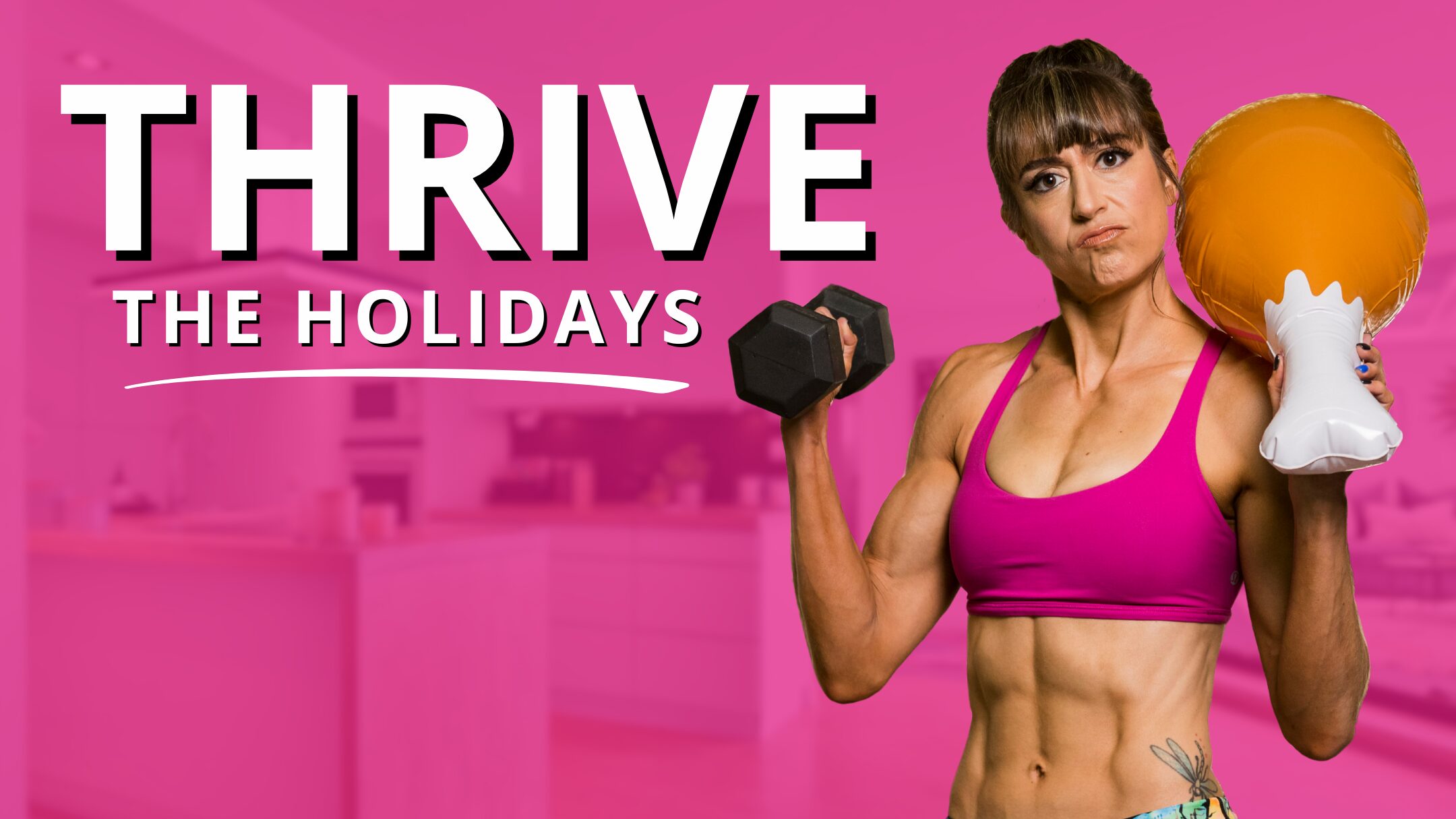Are push ups your arch nemesis?
Do you struggle to do even one?
Don’t worry, you’re not alone.
In this video I’ll share 10 tips to help you improve your push ups fast and be able to perform them flawlessly by addressing the common form issues and weak links we all tend to have!

Tip #1 is Regress to progress.
Sometimes you have to take that step back to truly improve.
Often we just keep trying a variation we haven’t earned yet and wonder why things aren’t progressing.
And it’s because we keep cheating or compensating to do a harder variation than we can control.
This can not only lead to injury but often keep us stuck.
Proper form, using the correct muscles to power the movement, is what makes us efficient with an exercise. And this efficiency is what strength truly is.
You can’t be efficient with a move you aren’t doing properly!
So if you’ve stalled, try modifying the move even just one step backward, off an incline instead of the ground, to refocus on what you feel working and make sure everything is engaging correctly in the correct order.
Get the correct muscles working. While it stinks to step back, this can help propel you forward!
Tip #2: Run through a set up checklist.
How often do you do a move and simply…well…do it?!
We don’t consider how we are positioning each part of our body or run through what we need to engage and how it needs to be engaged to do the move.
While we want this process of engagement to become natural, when first starting out is key we run through a checklist to make sure we have everything ready to work as it should!
So as you set up for the push up, run through a checklist of what you often struggle to engage to make sure you’ve set yourself up to move well from the start. Don’t just rush through hoping to mimic the movement.
A great set up checklist for overall form may be…
#1: Set your hands outside your chest and spread your fingers to drive down hard into the ground.
#2: Engage your back to unshrug your shoulders.
#3: Brace your abs, even squeezing your glutes to do a slight posterior pelvic tilt.
#4: Drive back through your heels as you flex your quads.
This sequence helps you make sure you’ve put yourself in a position to have the correct muscles engaged from the start of the movement.
Tip #3 is Drive back through your heels.
Often we think about the push up as an upper body or even a core move. But our lower body needs to be engaged correctly if we want to be efficient with the movement.
If we push ourselves forward over driving back, we can actually overload our upper body more.
And we can make it harder on ourselves for our body to move as one unit.
Instead, as you set up for the push up, drive back through your heels and feel your quads flex.
This will help you maintain proper plank alignment as you lower down.
It can help you avoid your butt going up in the air or shifting backward or forward.
It can even help you avoid those hips sagging because of the tension you’ve already set up through your legs!
Tip #4 is Set up at the bottom.
If you struggle with that press back up in a push up, it’s key you target that engagement from a dead stop.
A great way to do this is to actually set up at the bottom of your push up, whether you’re using an incline or doing these off the ground.
Just realize this is HARDER than lowering down because everything has to be fully engaged to press correctly BEFORE you even move. So don’t hesitate to modify starting out with this.
But set up at the bottom of the push up, run through your checklist to make sure everything is engaged, take a big breath in and then focus on that solid push up to the top as you exhale.
Too often we just work on moves top down, but that bottom up work can be so key especially if we do struggle with that transition from lowering down to pressing back up in a push up.
Tip #5 is Practice stick point holds.
Often there is a part of the push up we struggle with the most.
It could be maintaining a straight plank position at the bottom or in that push about half way up…
By using some push up holds in even our warm up activation work or as a burner to end our workout, we can build our strength endurance by HOLDING in these positions we struggle with.
You can not only cycle through these positions in a single interval, pausing in a spot for 5-10 seconds, but you can also do single longer holds just setting up directly at your stick point!
As you hold, run through how you feel everything working and your set up to really ingrain that positioning and recruit those muscles efficiently!
Tip #6 is Use a band.
While I love incline push ups to help build up, the more variations of a move we can include, the more we can help ourselves really learn to engage everything correctly.
Sometimes with incline or knee push ups, we can feel like we are getting stronger, yet still be slightly stuck.
The band is a great way to reduce tension on your upper body but work through that full range of motion off the ground.
It can also be a great way to increase your strength endurance if you’re stuck only able to do a few reps off the ground currently.
To do this, set up a band at about elbow height in a rig and position yourself in the push up with the band under your chest.
You can set the band up higher if you do need more assistance or have a higher stick point.
Then lower down performing the push up. As you get deeper in the lower down, the band will take away some of the load on your upper body and even add assistance as you push back up!
Tip #7 is Focus on pushing the ground away.
If you think about just lifting your body up, this often leads to our butt going up or some other version of the worm happening.
We lose tension on our foundation and a focus on the true movement pattern we are performing.
If you think about a bench press, your focus is on pressing the weights up.
You want that same focus in a push up to best activate your chest, shoulders and triceps.
With the push up, focus on pushing the ground away with your hands.
This can help you avoid your elbows flaring way up into a T shape with your body.
And it can help you remember to focus on powering that press with your upper body!
That tension down into the ground will truly better activate your pecs, shoulders and triceps!
Tip #8 is Include activation work in your warm up for your BACK.
Proper scapular control makes for a more powerful press.
If you want to protect your shoulders, neck and elbows as you work to improve your push ups, you want to make sure you include scapular mobility and activation work in your warm up routine.
If we are able to properly move our shoulder blades, we are better able to use our chest effectively in the push up as well.
In your warm up consider even a scapular wall hold as part of your activation series. This will open up your chest and engage your back, pulling your shoulder blades toward your spine.
It is a great way to make sure your back is ready to work and support those shoulders throughout the push up movement!
(It’s also a great move to improve your posture if you’re doing extra pressing).
Tip #9 is Use cluster sets.
If you want to be able to do more push ups in a row, you have to do more push ups in a row to build up that strength endurance.
Instead of modifying over rounds, consider designing your push up work as cluster sets.
Set a total number of reps for the round, say even the goal is 6.
And break it down into sets of what you can do well, even if that is just 2. Do 2 reps and rest 15-30 seconds then do 2 more. Do this pattern, even performing singles if needed to hit 6 then rest for longer between rounds.
This way you are still hitting your desired number of reps BUT in a way you can do each rep with the most challenging variation and proper form.
By resting for so short, you don’t let your body fully recover which can so to speak trick it into believing you’re able to do 6 in a row. You will see your strength endurance and push up reps increase quickly implementing this technique!
Tip #10 is Include anti-extension core work.
The push up is basically a moving plank.
And while planks are a great move to include, they can also get a bit boring, especially if you’re just doing the basic front plank.
So if you want to mix up your core work in a way that will really help your push ups, consider other anti-extension core exercises as part of a finisher to your workout.
It may be simply including a bird dog version of that front plank or even a dead bug variation that helps.
Anti-extension exercises are ones that make your abs work to avoid arching of your lower back, which will help you avoid your hips sagging in push ups!
You may even include an anti-extension move in your warm up to get your core ready to work and establish that mind-body connection prior to your push ups.
Just make sure you’re not doing too much to fatigue it prior.
Remember, the key to success is consistency and practice. So, make sure to incorporate these tips into your workout routine and track your progress over time.



0 Comments